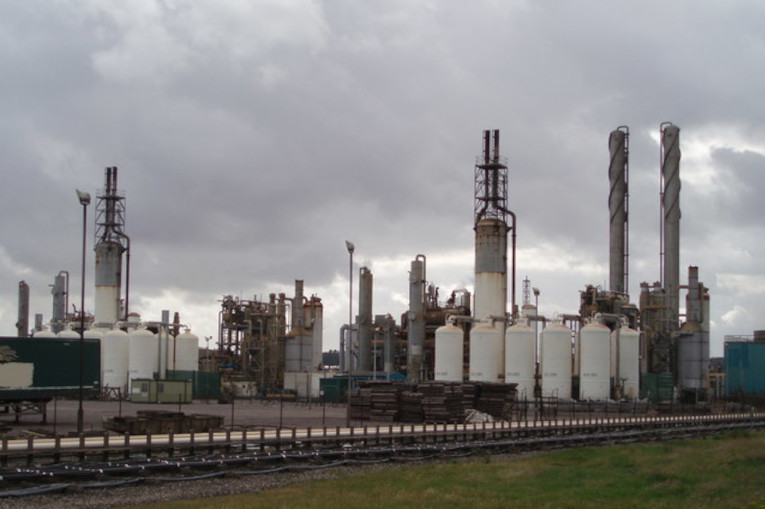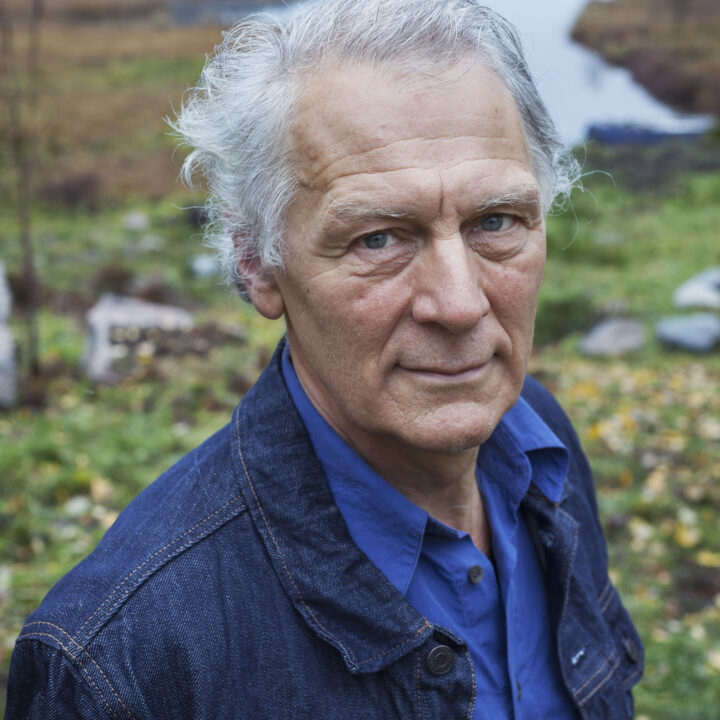How nitrogen fertilizers changed the food system. Part 2.
Some persons commented on social media that I, in my previous N-article, dismissed the often stated “fact” that without N-fertilizers the global population would be half the size or without them half of the global population would starve to death, without providing any evidence. But there is no evidence that those statements are correct so why should I have to provide evidence that they are not correct? My rejection of this has four different grounds:
1) There is no proof of causation. For sure, there are scientific articles by respected and serious scientists where one can read such statements (e.g. Erisman et al 2008, Smil 2002). But in none of them there is any evidence of causation here, just correlation. Even if there were causation, it would be quite hard to prove. If there is any causality between nitrogen fertilizer use and population growth, I would expect it to be that nitrogen fertilizers, together with global food trade, fossil fuels, seed breeding and irrigation, have made food a lot cheaper, which in turn is a strong incentive for having more children (until people get richer and other costs for children, such as education and mobile phones, become more important). Overall, my take in the question of food availability and population growth is that it is rather increased production that drives population growth than the other way round.
2) The global food system is characterized by enormous overproduction which has resulted in: a rapid increase in the use of grain and soy as animal feed, in particular to monogastric animals, pigs and chicken; cheap food and a huge waste of food; and the increased use of crops for bio-fuels. Theoretically, we produce crops to feed many more people than current population. (Rundgren 2022).
3) There are many ways that farmers can provide crops with nitrogen without using chemical fertilizers. Among them are the increased use of biological nitrogen fixation by bacteria; the reduction of losses by the use of cover crops, no till etc; and integration of livestock and cropping just to mention the more prominent methods.
4) The human waste, faces and urine, contain huge quantities of nitrogen, some 5-7 kg per person per year, i.e. some 40 Mt of nitrogen in total, more than 1/3 of the total quantity of N in N-fertilizers. Almost nothing of this is recycled to the fields.
I will come back to the two last points in the last article in my N-series.
As been stated in the introduction, nitrogen fertilizers have had a huge impact on agriculture. All things equal, the addition of N-fertilizers will boost yields considerably in a wide span. One approach when applying N-fertilizers is to apply “what the plant needs”. This leads to a systemic oversupply as the total need of the plant is not what is taken away as harvest, e.g. in wheat around 50% of the biomass is in the harvested grain*. In addition, the dose of fertilizers is often based on optimistic assumptions of the yield but as any grower knows there are many reasons for why the actual yield is much lower than the theoretical possibility. In general, nitrogen use efficiency in the agriculture system is low and around 60% of the nitrogen is lost in the fields already (Einarsson 2024). Having said that, in the countries where artificial fertilizers have been used on a larger scale at least since end of WWII, the losses have been reduced over time and farmers use fertilizers more diligently. Still, also there, losses from croplands are high.
According to estimates, less than ten percent of all fertilizers are used on permanent grasslands. Biological nitrogen fixation and atmospheric deposition is more important N-sources on grasslands and the losses of N from grasslands is mostly low (Rumpel et al 2015, Le Noë, Billen and Garnier 2017, Einarsson 2024). Even if there is an enormous variation, there is a net fixation of nitrogen into most grasslands in the form of increasing soil organic matter (e.g. Chang et al 2021) , which mostly have around 1 kg of N to 10 kg of C. Which means that if you sequester 1 ton of carbon, you are likely to also sink 100 kg of nitrogen (I will come back to this later).
All nitrogen is lost
Looking at the whole agri-food system one could claim that all nitrogen is lost. This may sound as a horrific and to some extent it is. But one need to keep in mind that while nitrogen is recycled within ecosystems there will always be some losses and a need for addition. Even in a natural ecosystem, sooner or later, all that comes in will go out or vice-versa .Most natural ecosystems are N-limited which means that there will be a lot of organisms licking up whatever reactive nitrogen there is. Most traditional agriculture systems have also been N-limited with very low losses of N, but also rather low yields. With artificial fertilizers the N-limitation was broken and losses have sky-rocketed. The problem with the agri-food system is the magnitude of this process and the many quite avoidable losses there are underway.
In 1961, the amount of synthetic N, 12Mt, applied to the agriculture soils was almost identical to the amount N in the food of humans, which in turn resulted in an equal loss as almost all N that humans consume can be found in the urine and faces (it is only in the growth phase that we accumulate N in the body, N which again will be released when we die, but the N stored in human bodies is really small and insignificant). In 2013, 111 Mt of synthetic N was used while only one third of this reached humans. The reason for this are not only that losses in the field has increased a lot but changes in livestock production play a major role. A much higher share of livestock feed now originates in croplands compared to grasslands. 1961 around 70% of all N in livestock feed came from grasslands, in 2013 this was less than half (See graph from Einarsson 2024).
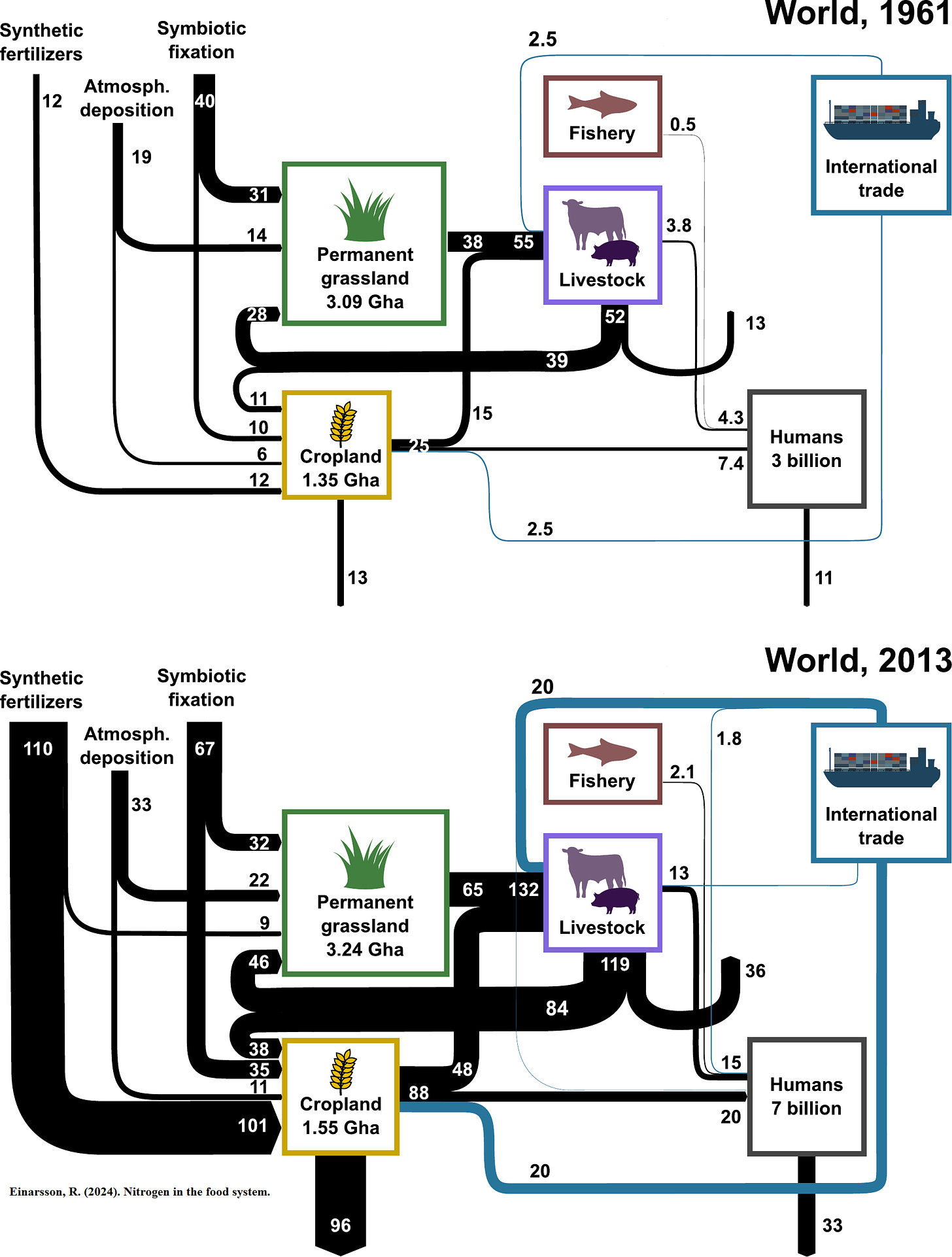
In addition, losses from livestock manure has increased a lot. Both these are linked to the increased use of N-fertilizers. The total crop output increased with 268% between 1960 and 2020, while global population increased with “just” 151% (Rundgren 2022). This means that crops like corn, soy and wheat has become very cheap and thus used as feed for animals as well as feedstock for bio-energy.
Separation of crops, animals and people
Meanwhile, the possibility for crop farmers to use synthetic fertilizers of N,P and K also meant that they could specialize in crop farming instead of having mixed farming, which was the common practice in most parts of the world. And livestock farms specialized in livestock of one kind. Today some livestock farms, in particular poultry farms, grow no feed at all and thus have a lot of manure which in the worst case is dumped but mostly is spread, but too much in one place, at the wrong time etc. This separation of livestock and feed is a major cause of nitrogen losses. The total opposite is when livestock is grazing, i.e. when there is no separation at all between feed production and animal consumption. Then there are almost no losses of nitrogen. Of course, the losses in the human “livestock” is much worse, proportionally. Since the advent of the WC almost no nitrogen is recycled to the fields. When/if sewage sludge is recycled the nitrogen is lost in the process (while most phosphorous stays in the sludge) and the sludge is often so contaminated that farmers shouldn’t use it. This is also a result of separation of people from the land, in enormous human feedlots called cities.
In this way, nitrogen is a key component of a dysfunctional food system. Together with fossil fuels and the market economy it is not only a key component but a key driver as it becomes its own justification and the more you use of it, the more you need.
While the links and mechanisms are not totally apparent, the introduction of synthetic fertilizers broke most of the links between the land, the animals and the people. This separation has many results and impacts on what we eat.
I have already demonstrated that it led to an overproduction of grains which in turn led to low prices. This meant that more grain was fed to livestock, in particular chicken and pigs. But also cattle has increasingly been fed with grain, typically starting in the part of the world that first experienced this huge overproduction, North America. The result is that people eat more meat from grain fed monogastric animals and more meat from grain fed cattle as opposed to meat from grazing cattle, sheep and other grazers. The cheapness of the meat also led to a reduced consumption of intestines such as liver and kidneys and that a considerable share of edible meats are fed to cats and dogs, or even made into biogas. The increased production of vegetable oils also resulted in that animal fat is less used and the combination of less demand for animal fat and the industrialization of livestock also meant that animals are much leaner today than earlier. It takes much more feed to produce 1kg of fat than 1kg of meat and with optimization of feed rations animals can grow rapidly without being fat. In addition the share of fat in the body tend to increase with age while feed conversion ratio goes down, so animals are mostly slaughtered at an earlier age today than earlier – resulting in a tasteless meat. But I digress, this is the topic of article 4.
Synthetic fertilizers also changed the crops, directly and indirectly. When synthetic fertilizers are applied the plant grows vigorously, but in the end the contents of minerals, vitamins, antioxidants and other substances, including those that give taste and flavor are diluted, so the nutritional qualities go down. This is exacerbated by plant breeding that has increased yields as main purpose and is based on ample supply of fertilizers. This leads to plants with a higher harvest index (more kernel and less straw and root) which in turn means that the plant is less able to look for the nutrients it needs – and nutrients we need. The plant is also less motivated to exchange energy (carbohydrates) for nutrients with the steaming microbiome of the soil. That is the subject of the next article.
Nitrogen fertilizers cost a lot of money and is a strategic resource.
Nitrogen fertilizers are energy-intensive and therefore they are subject to the price fluctuations of fossil gas, oil and coal. Over all crops in the U.S., fertilizer input costs account for only about one fifth of farm operating costs on average at constant prices, according to U.S. Department of Agriculture estimates. For maize and wheat, this share is higher—around 35%. In many countries the prices of fertilizers are much higher than in the U.S. This is particularly the case in land-locked countries with no own production and low use, e.g. in Sub-Saharan Africa. Many governments subsidize fertilizers, often with international aid money. The results are contested to say the least (as a means to buy rural votes it seems to be efficient though).
The countries with the highest production of N-fertilizers are China, India, USA and Russia, with China alone producing a quarter of all N-fertilizers. 40% of all N-fertilizers are traded globally with Russia, China, Qatar and Saudi Arabia being the biggest exporters with Russia and China with around 15% of the exports each. Major importers are India, Brazil, USA and France.
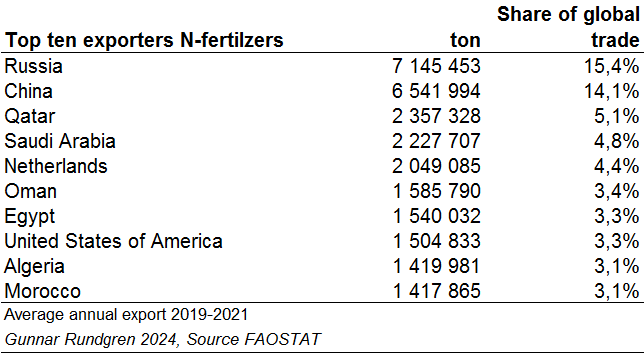
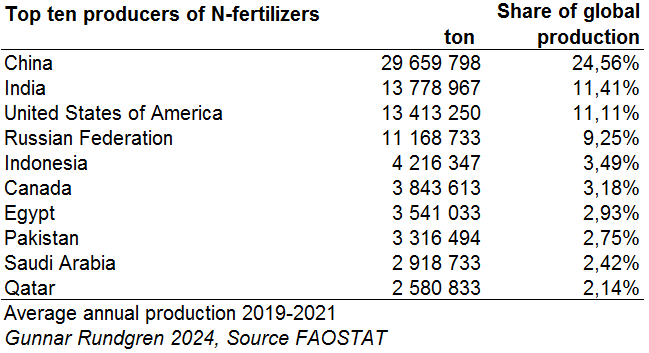
Notably this is about trade in fertilizers, there is also a big trade in fossil gas and ammonia, both used as raw materials for the production of N-fertilzers. Trinidad and Tobago, Russia and Saudi Arabia are major exporters of ammonia (OEC).
Reactive nitrogen is also a major component in gunpowder and explosives. As a matter of fact the real breakthrough for nitrogen fertilizers came after WWII because there was such an overcapacity of ammonia and nitrate production for war which found a new market. One of the articles claiming that the Haber-Bosch process (by which ammonia is produced, i.e. the raw material for both N-fertilzers and ammunition) feeds half of the human population also note that the same process can be linked to 100-150 million deaths in armed conflicts (Erisman et al 2008). I tried to find more data in how the availability of N-compounds effects the capacity for production of ammunition today but failed to find good data. However, it is apparent that Europe is dependent in China for nitrocellulose for its gunpowder production.
Until now I discussed the effects of nitrogen on the metabolism of the human society as well as the effect on farm operations on a firm level. But the impacts also goes down into the soils and into our bodies as well.
To be continued….
* This proportion has changed as a result of modern seed breeding as well as the better availability of nutrients and water in modern cultivation. There is a much higher harvest index for modern varieties as they don’t have to invest in roots.
References
Chang, J., Ciais, P., Gasser, T. et al. Climate warming from managed grasslands cancels the cooling effect of carbon sinks in sparsely grazed and natural grasslands. Nat Commun 12, 118 (2021). https://doi.org/10.1038/s41467-020-20406-7.
Einarsson, R. (2024). Nitrogen in the food system. TABLE Explainer. TABLE, University of Oxford, Swedish University of Agricultural Sciences, and Wageningen University and Research.
Erisman, J.,et al How a century of ammonia synthesis changed the world. Nature Geosci 1, 636–639 (2008). https://doi.org/10.1038/ngeo325.
Le Noë, J., Billen, G., Garnier, J. How the structure of agro-food systems shapes nitrogen, phosphorus, and carbon fluxes: The generalized representation of agro-food system applied at the regional scale in France, Science of The Total Environment, Volume 586, 2017, Pages 42-55.
Rumpel, C. et al. The impact of grassland management on biogeochemical cycles involving carbon, nitrogen and phosphorus. J. Soil Sci. Plant Nutr. [online]. 2015, vol.15, n.2.
Rundgren, G. Food and agriculture number crunching, part 1, Garden Earth Beyond sustainability, 28 November 2022.
Smil. V Ambio 31, 126-131 (2002).


